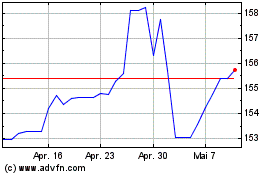U.S. Dollar Dips On Election Uncertainty
06 November 2020 - 11:12AM
RTTF2
The U.S. dollar weakened against its major counterparts in the
European session on Friday, as continued uncertainty about the
outcome of the U.S. presidential election made investors
cautious.
Democratic challenger Joe Biden gained more ground on President
Donald Trump in the battleground states of Georgia and
Pennsylvania, and expanded his lead in Nevada.
As votes continued to be counted and Democrat Biden edges closer
to victory, the Trump team is pressing legal challenges in several
states.
Biden has secured 253 electoral votes, while Trump won 214
votes.
Data from the Labor Department showed that U.S. employment rose
more than expected in October.
The report said non-farm payroll employment jumped by 638,000
jobs in October after surging up by a revised 672,000 jobs in
September.
Economists had expected employment to increase by 600,000 jobs
compared to the addition of 661,000 jobs originally reported for
the previous month.
The Labor Department also said the unemployment rate dropped to
6.9 percent in October from 7.9 percent in September. The
unemployment rate was expected to slip to 7.7 percent.
The dollar has been falling in the Asian session as investors
awaited the latest news about the U.S. presidential election.
The greenback slipped to 0.8985 against the franc, a level
unseen since January 2015. At Thursday's close, the pair was valued
at 0.9038. The dollar is seen finding support around the 0.86
region.
The greenback declined to 103.18 against the yen, its lowest
level since March 9. The pair was worth 103.45 when it ended deals
on Thursday. Should the currency extends decline, 100.00 is
possibly seen as its next support level.
Data from the Ministry of Internal Affairs and Communications
showed that Japan household spending fell 10.2 percent on year in
September - coming in at 269,863 yen.
That beat forecasts for a decline of 10.7 percent following the
6.9 percent drop in August.
The greenback dropped to near a 2-month low of 1.1891 against
the euro, compared to yesterday's closing value of 1.1821. Next key
support for the currency is likely seen around the 1.20 level.
Data from Destatis showed that German industrial production grew
at a faster pace in September.
Industrial output climbed 1.6 percent on month, bigger than the
0.5 percent rise seen in August but slower than economists'
forecast of 2.7 percent.
The U.S. currency pulled back to 1.3042 versus the loonie, after
rising to 1.3097 at 11:00 pm ET. The greenback was trading at
1.3044 per loonie at yesterday's close. On the downside, 1.29 is
possibly seen as its next support level.
In contrast, the greenback rebounded to 0.7242 versus the aussie
and 0.6770 versus the kiwi, from its early low of 0.7287 and a
1-1/2-year low of 0.6802, respectively and was steady. On the
upside, 0.70 and 0.66 are possibly seen as the next resistance for
the greenback against the aussie and the kiwi, respectively.
The greenback rose to 1.3093 versus the pound, after hitting
1.3157, which was its weakest level since October 21. The
pound-greenback pair had finished yesterday's trading session at
1.3146. Immediate resistance for the currency is likely seen around
the 1.29 level.
Data from the Lloyds Bank subsidiary Halifax and IHS Markit
showed that UK house prices increased at the fastest pace since
mid-2016.
House prices increased 7.5 percent on a yearly basis in three
months to October from the same period last year, the strongest
rise since June 2016. Prices had advanced 7.3 percent in three
months to September.
US Dollar vs Yen (FX:USDJPY)
Forex Chart
Von Mär 2024 bis Apr 2024

US Dollar vs Yen (FX:USDJPY)
Forex Chart
Von Apr 2023 bis Apr 2024
